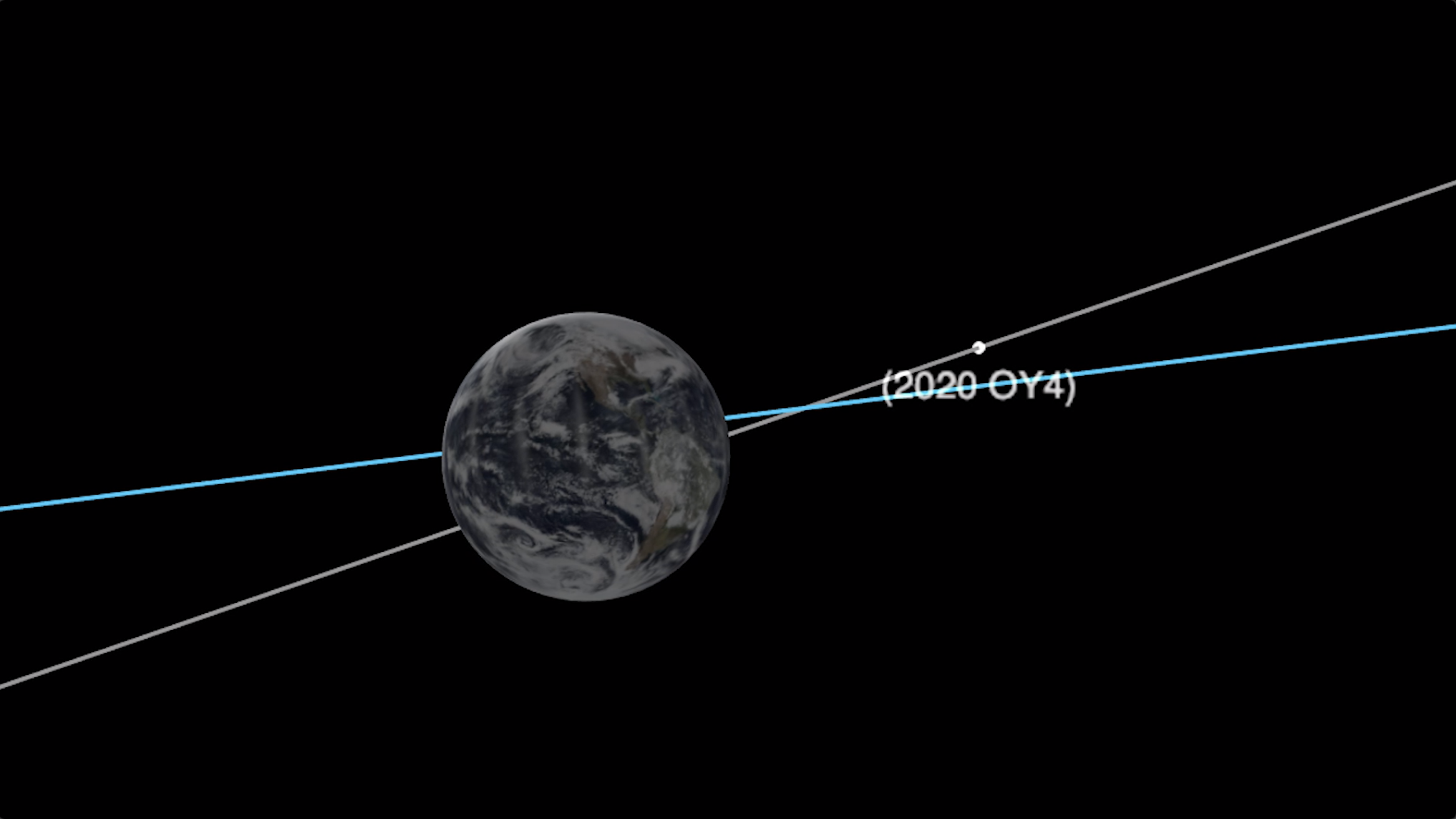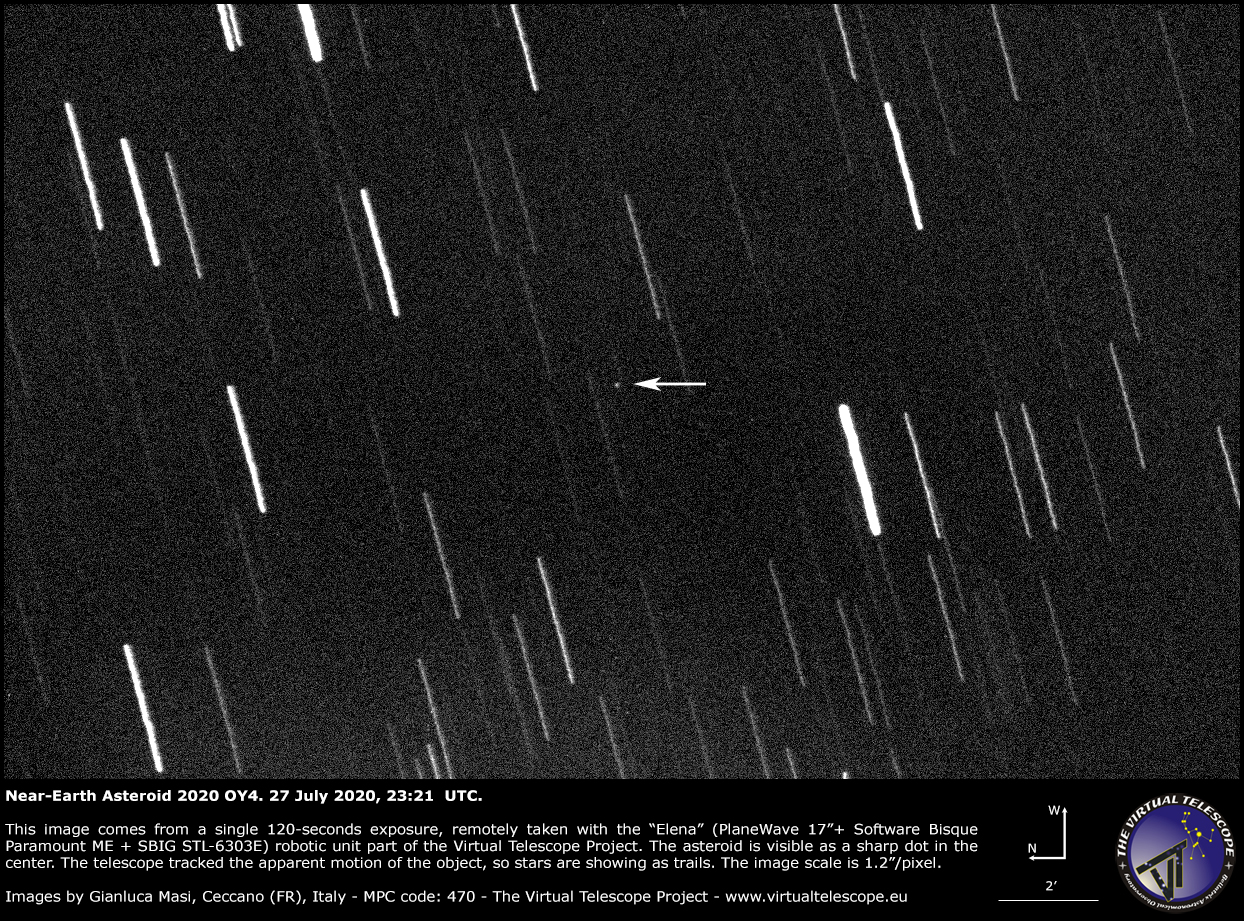An asteroid the size of a car just zipped by Earth in close flyby
It posed no danger to our planet.
A car-sized asteroid discovered over the weekend made a close flyby of Earth today (July 28), passing our planet at a range that rivals the orbits of some high-flying satellites.
The asteroid 2020 OY4, which was first detected on Sunday (July 26), made its closest approach today at 1:31 a.m. EDT (0531 GMT) when it zipped by Earth at a speed of about 27,700 mph (44,600 km/h), according to the European Space Agency. The asteroid is just under 10 feet (3 meters) wide and posed no impact risk to Earth, but did approach the flight paths of geosynchronous satellites.
"A tiny, 3 meter asteroid called 2020 OY4 skimmed past Earth just a few hours ago, passing within the orbit of satellites in the geostationary ring," ESA officials wrote in a Twitter update.
Video: Watch asteroid 2020 OY4's orbit and flyby animation
Related: Famous asteroid flybys and close calls (infographic)

Estimates from ESA's Center for Near-Earth Object Coordination Center and NASA's Asteroid Watch outreach tool vary in the exact distance of asteroid 2020 OY4 at its closest approach.
NASA's tool listed the closest distance as about 25,800 miles (41,400 km), which is just outside the ring of geosynchronous satellites 22,236 miles (35,786 km) above Earth's equator. ESA's asteroid-tracking center pegged the flyby range at about 21,900 miles (35,170 km), or just inside the satellite orbit ring.
"Of course, there were no risks at all to our planet," wrote astrophysicist Gianluca Masi of the Virtual Telescope Project in Ceccano, Italy.
Get the Space.com Newsletter
Breaking space news, the latest updates on rocket launches, skywatching events and more!

Masi captured a photo of asteroid 2020 OY4 on Monday (July 27), just ahead of the flyby. In the image, the asteroid looks like a bright dot on a sea of black streaked by star lines.
"The telescope tracked the fast apparent motion of the asteroid; this is why stars show as long trails, while the asteroid looks like a bright and sharp dot of light in the center of the image, marked by an arrow," Masi wrote in an image description.
Asteroids the size of 2020 OY4 fly by Earth several times a month, NASA officials have said in the past. In June 2019, an asteroid slightly larger than 2020 OY4 actually hit the Earth, but broke up harmlessly in the atmosphere, astronomers said.
Email Tariq Malik at tmalik@space.com or follow him @tariqjmalik. Follow us @Spacedotcom, Facebook and Instagram.
Join our Space Forums to keep talking space on the latest missions, night sky and more! And if you have a news tip, correction or comment, let us know at: community@space.com.

Tariq is the Editor-in-Chief of Space.com and joined the team in 2001, first as an intern and staff writer, and later as an editor. He covers human spaceflight, exploration and space science, as well as skywatching and entertainment. He became Space.com's Managing Editor in 2009 and Editor-in-Chief in 2019. Before joining Space.com, Tariq was a staff reporter for The Los Angeles Times covering education and city beats in La Habra, Fullerton and Huntington Beach. In October 2022, Tariq received the Harry Kolcum Award for excellence in space reporting from the National Space Club Florida Committee. He is also an Eagle Scout (yes, he has the Space Exploration merit badge) and went to Space Camp four times as a kid and a fifth time as an adult. He has journalism degrees from the University of Southern California and New York University. You can find Tariq at Space.com and as the co-host to the This Week In Space podcast with space historian Rod Pyle on the TWiT network. To see his latest project, you can follow Tariq on Twitter @tariqjmalik.
-
Jeff W Wait... How were they able to discover this asteroid? I though the Starlink satellites had destroyed earth based Astronomy? Does this mean rural communities around the world can have internet and Astronomy can continue to discover and research at the same time?Reply -
foxpup Reply
Yup. :-) What anti-SpaceX crazies refuse to acknowledge, because it doesn't serve thier cause, is that Starlink satellites only shine when they are NOT in the Earth's shadow, but of course they often are and (with the exception of summer at high lattitude) at local midnight ALL near-earth orbital objects above you are in the Earth's shadow. I have brought that up repeatedly in various contexts and the silence in responding has been amazing. They cannot refute it because doing so would be false and cannot support it because it is politically incorrect....so you hear crickets. :-)Jeff W said:Wait... How were they able to discover this asteroid? I though the Starlink satellites had destroyed earth based Astronomy? Does this mean rural communities around the world can have internet and Astronomy can continue to discover and research at the same time?









